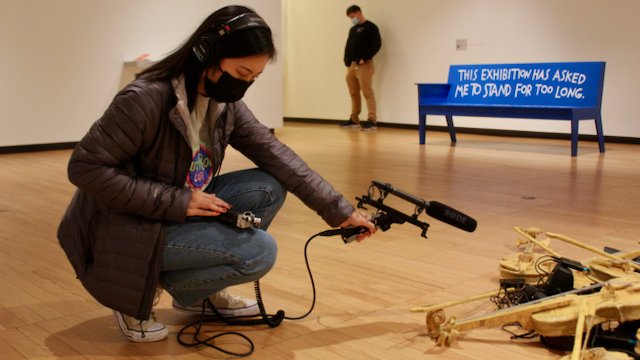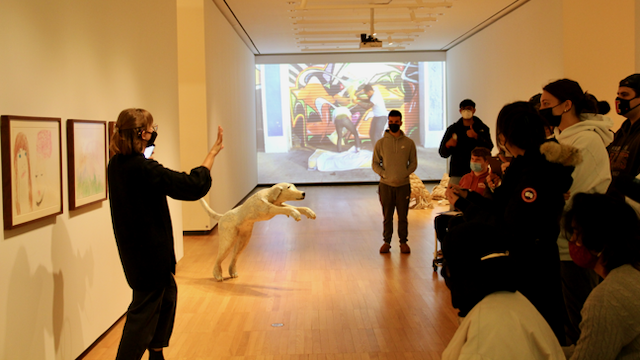Editor’s note: At the request of Nikki Usher, we changed the pronouns in this article that pertain to Usher from ‘she’ to ‘they.’ – Reginald Hardwick, News Director, March 26, 2024
CHAMPAIGN, Ill. – The Krannert Art Museum in Champaign has two entrances. One entrance is at the top of a flight of concrete stairs, past a garden.
Beyond glass doors, there’s a front desk and lockers to place personal items.
But University of Illinois journalism students, on a class trip for their journalism ethics and diversity class, didn’t go through this entrance.

Instead, they went in from all the way across the building, through the wheelchair-accessible entrance.
After walking through the greenhouse-like area, the students had to go past multiple exhibits to reach the front desk for their tour on an exhibit called “Crip*”.
The exhibit ended its showing at the Krannert Art Museum in early December but will begin again in January at the University of Illinois campus in Chicago.
The exhibit is intended to address the many ways in which museums – and society as a whole – often overlook challenges for people with disabilities, said Liza Sylvestre, the exhibit’s curator.
Different entrances, lack of seating and not having adequate audio descriptions were some of the issues this exhibit wanted to challenge, she said.
A lot of museums include recorded oral descriptions, such as those that accompany all the pieces in “Crip*”. They’re either played on loop – loud enough to be heard from other exhibits in the museum – or accessible through a QR code.
Sylvestre, who is deaf, said the exhibit featured work from artists with disabilities or addresses accessibility as an issue.
The exhibit’s name is a reference to Crip theory, created by University of Illinois graduate Robert McCruer.
His theory suggests that our understanding of disability is connected to what society defines as “normal”, and how many people expect people with disabilities to meet this definition.
When Sylvestre gave an exhibit tour to the journalism students in October, she said disability is never as simple as the media would like it to be.
“We have a tendency to simplify stories, and present them in sort of neatly edited packages,” she said. “And the real story is so much more complicated.”
Audio also played as part of the art pieces, like a monitor playing the film “Tuba Thieves” where artist Alison O’Daniel explores what happens in the absence of sound.
There were also the sounds of a violin being plucked coming from a collection of the instruments and speakers in the middle of the exhibit floor.
The speakers played the song “Pure Imagination” from the film “Willy Wonka and the Chocolate Factory”.

Artist Christopher Robert Jones said the piece ties into disability because it asks viewers to think about the lengths someone will go to fit in, which is also a central theme of “Willy Wonka”.
Students in the journalism class were asked to write a verbal description for any piece in the exhibit and then write a reflection on the experience.
Beyza Vural, a senior journalism student, wrote her description for drawings by Emilie Gossiaux. Gossiaux, who is deaf and blind, does not want viewers to imagine what it would be like to be her.
Gossiaux uses the art materials – like the indentations of a ballpoint pen or the texture of wax crayons – to gauge her position on the page.
In her written description for this piece and experiencing the exhibit, Vural said journalists have to be aware of systemic barriers that shape stereotypes about people with disabilities.
“I think journalists should be more aware of these conceptions that we’ve had for so long,” she said. “I think all of [the artwork is] really useful for us to see and learn.”
Alexis Ramirez, a senior in journalism and graphic design, echoed this sentiment. He said accessibility is something all journalists should strive for.
For years, Ramirez said he’s heard his peers and colleagues call subtitles “a chore.”
But similar to audio descriptions in a museum, he said, they’re the bare minimum of what journalists should do.
“It is such an important part of giving people the ability to experience the content that we were producing, in the same way that anyone else could,” he said.
Having to enter from the wheelchair-accessible entrance made Ramirez think about how everyone should be able to use all entrances.

“There’s really a lot more that we could do and have it be the standard – that idea of what we consider normal,” he said.
Kevin Hamilton, another senior in journalism, uses a wheelchair. He said he has always known how disability is viewed by society and how many don’t understand the whole range of experiences people can have with disability.
“Everybody does perceive the world within what they can do,” Hamilton said.
Hamilton said disability is often left out of conversations about diversity, but also said he has seen improvements in the way the media represents people with disabilities. .
Nikki Usher, a U of I journalism professor, teaches the journalism ethics and diversity class.
They said students can learn about ethics and diversity by learning about the community on campus.
“Going into a place that has art, you’re giving the artists a chance to tell you something,” Usher said. “You’re opening yourself up to listen and experience in a different way.”
As for the assignment where students had to write verbal descriptions, Usher said it was important to teach future journalists to recognize what they can or can’t experience.
This awareness will help them tell better stories about others, she said.
“I think that it couldn’t be more connected to the mission of journalism itself,” Usher said.
“Because you can only listen to what other people’s experiences are, you can’t have them yourself.”
The exhibit will be shown at the University of Illinois at Chicago starting in January and be there until March.
For Sylvestre, who said putting the exhibit together has been rewarding, the experience is more about what visitors like the journalism students take away.
Most people won’t become disability scholars, but she said journalism has everything to do with disability.
“I think that everybody has something to gain from disability,” Sylvestre said. “We’re all responsible for everyone’s access.”

